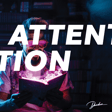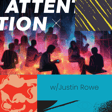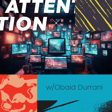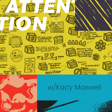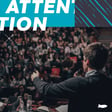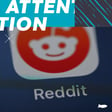Become a Creator today!Start creating today - Share your story with the world!
Start for free
00:00:00
00:00:01

Advice For Managing the Creative Ideas of Your Team w/Mark Jung
In this episode, Dan Sanchez talks to Mark Jung who is the VP of Marketing at Dooly.
- Dooly's MVP model for content
- How he ranks creative content ideas
- And the advice he would give to his past self before building a media empire
Thank You For Listening to the Attention Podcast! Don’t forget to hit Subscribe or Follow us on your favorite podcast player so that you never miss an episode! If you want this podcast delivered to you via email, you can subscribe here: https://www.theirattention.com/p/subscribe/
The Attention Podcast is brought to you by Sweet Fish, the podcast agency for B2B brands.
- Dooly's MVP model for content
- How he ranks creative content ideas
- And the advice he would give to his past self before building a media empire
Thank You For Listening to the Attention Podcast! Don’t forget to hit Subscribe or Follow us on your favorite podcast player so that you never miss an episode! If you want this podcast delivered to you via email, you can subscribe here: https://www.theirattention.com/p/subscribe/
The Attention Podcast is brought to you by Sweet Fish, the podcast agency for B2B brands.
Transcript
Introduction to The Attention Podcast
00:00:03
Speaker
Welcome back to The Attention Podcast, where you learn how to gain and retain the attention of your buyers to build an audience.
Interview with Mark Young: Managing Creative Ideas
00:00:10
Speaker
I'm Dan Sanchez with Sweetfish, and today I interviewed Mark Young, who is the VP of marketing at Dooley, about his advice for managing the creative ideas of your team.
Dooley's MVP Content Model and Advice to Past Self
00:00:19
Speaker
In the episode, we cover Dooley's MVP model for content, how he ranks creative content ideas, and the advice he would give to his past self before building a media empire. All right, let's get into it.
00:00:37
Speaker
Mark, welcome to the show. Thanks so much for having me, Dan. Excited to kick off with you. Absolutely.
Building a Media Empire at Dooley
00:00:42
Speaker
So I've really been looking forward to this interview because Dooley has been killing it when it comes to creating all kinds of content. You guys got, of course, blogs and podcasts, but then you have fire talks, right? So you're really getting creative with how you're approaching content. And I want to know, like, what led to you thinking about building this kind of immediate empire for Dooley?
SaaS Companies and Audience Relationships
00:01:01
Speaker
Yeah, so Dewey is my first official SaaS gig. Before that I was in management consulting and very much focused on larger Fortune 100 B2B brands and that was kind of the space that I was in. And I just saw a really interesting trend where the best SaaS companies, being an outsider to SaaS,
00:01:18
Speaker
we're starting to take an approach similar to what a lot of really strong consumer packaged good companies have done, which is building a very unique, tight relationship with your audience, and often that happens through what has now become known as a media arm. I really didn't see B2B companies leaning in and making this play, and I thought it's a massive missed opportunity. There's very few in the sales space specifically that have done this,
00:01:42
Speaker
and in order to win the hearts and the minds of your audience, you need to show up authentically in the places that they care about, not always selling, but just showing up as a brand like it would be meeting a friend for drinks one
Dooley's Strategy for Authentic Connections
00:01:55
Speaker
night. So I said, hey, we're going to find a way to do this. We might be a scrappy eight-person startup at the time, but there is a path forward here, which is something that I'm a big believer in and has led to where we are today.
00:02:07
Speaker
As
Growth of Dooley's Media Arm
00:02:08
Speaker
you envision building this media empire, where do you see it going? How big do you see it becoming? Is it kind of at its final stage? I mean, probably not, but where do you see it going now that it's here where it's at? I would say we're literally just getting started. I think that in the next
Importance of Authentic Media Strategy
00:02:25
Speaker
probably three to five years, you're going to start to see some really key marquee SaaS players leading the charge and starting to become
00:02:35
Speaker
really more like global brands that have probably sister or sub brands within them as part of a larger media arm. So when I look at the companies that inspire me, you know, when we had our pre-chat, I was mentioning probably the most talked about example when you look at HubSpot, right? There's a reason that HubSpot acquired the hustle back in, you know, I think it was February of last year. It's not because they are using it to promote HubSpot, they're using it to have great satirical content that is deeply embedded in
00:03:04
Speaker
the SaaS ecosystem so that when people think of something that they love and interact with in a daily basis, what are you associated with? You're associated with HubSpot. In the same way that Coca-Cola has become synonymous with the holidays and Santa Claus and Christmas and positive good feelings, it is, I don't know, 40 or 50 grams of sugar in a bottle, but that emotional connection is there.
00:03:29
Speaker
a media arm strategy is just like a hot topic that a lot of companies are taking all we'll just buy our way to this and i think in the next one to two years a lot of those investments will fail and people realize it needs to have more of a grassroots movement and we're starting to see companies paving that path forward.
00:03:47
Speaker
So coming back to question i think we're still very early at dually specifically we are just getting started this is a long term investment in a multi year process but i'm really excited to see some of the creative and interesting partnerships and strategies that other companies will begin to roll out in a way that could be.
00:04:05
Speaker
fashion brands or wines of energy drinks or beverages or just fun, unique, interesting things that will break up some of the monotony of what happens in SaaS, so I'm really excited.
00:04:17
Speaker
So you said one of the things you're trying to do is create an emotional attachment with the audience.
Empathizing with Sales Leaders for Brand Connections
00:04:22
Speaker
What kind of emotional attachment are you trying to create with Dooley? So for us, when I joined Dooley, I can kind of backtrack to my first 30 days and what led to some of the decisions that we made. I had never sold or marketed to sellers before. I didn't really understand the sales ecosystem. My background was always just in a very niche markets and I didn't really understand the SaaS sales ecosystem at all.
00:04:45
Speaker
So in my first 30 days doing a lot of discovery, chatting with sales leaders, I realized that sales are a really stressful job and probably one of the most stressful, highest pressure. And because of that, sellers, specifically sales leadership, account executives, whoever it might be, really needed an outlet for that stress. And I realized that there were some really deep social and emotional pains that they felt
00:05:09
Speaker
that we could use and kind of tap into to both one have some fun you know be lighthearted give them a laugh give them like a reprieve from like what is typically going to be a very like full tilt day or week and that's typically the relationship that we've tried to build of our media approach a do we.
00:05:25
Speaker
It's not about, you know, talking too much about the product or what it solves for, but when you're a sales leader and you're about to walk into your board meeting the next week and your CEO says, hey, I need your forecast to be accurate, but double it. That's like a terrible situation. That's like a high pressure, you're worried, you're not sleeping well. You know, like that's the type of thing that's like a funny oh shit moment that a sales leader is like, yes, I empathize with that. That is my life.
00:05:51
Speaker
and it's something that people can appreciate and gravitate towards. Those are the moments where it's authentic, it's fun, it ties back to a social or emotional pain, and it really just feels right for the audience. They created the content themselves. That's what we try to build at Dewey. That's a big part of our philosophy, is showing up to really be by sales for sales. That's a great way that you can start to connect with your audience.
00:06:15
Speaker
So it was about empathizing with those hard moments of being in sales. I missed like, what was the actual like, I didn't hear like a one-liner of like the emotion you're trying to leave. Yeah. So it really depends. The emotion is more, I would say if we were going to boil it down to one word, it would be authenticity or connection, which is I understand what you are going through.
00:06:36
Speaker
And it is very hard and people outside of sales may not get it but we are here together right and like that's what we really tried to shoot for it's just understanding and being seen a lot of times in sales like there's the age old marketing versus sales. Marketing doesn't give me any good leads to close you know sales can close the leads that i give them right and there's a fun dynamic there that has i think been.
00:07:01
Speaker
some really good satire recently on LinkedIn. But that's the way that we approach the connection that we try to build. It's just that. It's not like, hey, we need to create a sense of, I want to be seen as a provider for my family. I want to be able to sleep well at night. I want to show up as being respected among my peers. We're not going very, very deep at that level. We're just focusing on connection and then taking different fun tracks to get there.
00:07:31
Speaker
So one of the things I run into with launching great social campaigns, great content, is having that creative element that just puts it beyond commodity content, which we aggressively just try to attack at Sweetfish. Sometimes it's hard to collect and vet those ideas. You can have brainstorming sessions with your employees, but then you're like, oh, that's a great idea, Jimmy.
Informal Vetting of Creative Ideas at Dooley
00:07:51
Speaker
They're not all great. So how do you actually run through that as a marketer with your team?
00:07:58
Speaker
So we have a fairly informal but multi-step process at Dually. So one of the things that we always focus on at Dually is our job as marketers is pretty simple. It's make sales easier. We want to create a brand that people, when our BDR team emails someone or calls someone or send a DM, they're like, oh yeah, I've seen Dually before.
00:08:20
Speaker
love the content, I have an idea of what you're about, but tell me more. So that's always the begin with the end in mind. Anytime we're creating a campaign, we think one, is it going to achieve that outcome? Two, is it going to feel authentic and relatable for
00:08:35
Speaker
sellers, both like account executives and people who use our product, and then sales leadership who care about the data and the outcomes from it. So we approach those in the two tracks. We tend to use an ICE framework fairly loosely, but looking at like, hey, based on past experiments like this, what is our confidence level that this is going to be successful? Okay, what's the impact of it if it is successful? And then how much effort do we actually need to put into this to make it happen?
00:09:01
Speaker
Then from there, what we try to do is we use an MVP model, so our minimum viable product. We say, okay, you have an idea. We can't invest 45 days digging into this creative without knowing how it's going to work. How do we shift this today? What is the lightest form of this idea that we can shift to validate to see if there's demand, if there is traction? Sometimes it's as simple as, I put up a poll on LinkedIn. We post something on social. We e-mail 50 sales leaders. We post in a Slack.
00:09:29
Speaker
That's usually like the original way of taking a creative idea of vetting it, seeing if it has legs within under, you know, six hours during the business day. And then if we have people that are saying like, yes, this is great. I love it. We say, okay, great. And if people are like, oh, I didn't quite get it. Maybe we missed the mark. We come back and we'll refine or we'll put it into what we call like the flavor graveyard, like Ben and Jerry's.
00:09:51
Speaker
So we have a Slack channel, we have the idea dump, and then we have a biweekly brainstorm demand gensync, where we have a dot voting system. So we'll say upvote, you only get two votes, you put your votes on the most interesting ideas to you, and then we'll chat about those and say, hey, we'll pick one together that we think could be a good idea to add to the next growth sprint, and then we'll strategize around it.
00:10:13
Speaker
But I think you really need to trust your subject matter experts on, for example, if you had a distribution channel and you're working with a partner, don't neglect their multiple years of not only instinct, but experience on what's going to perform on that channel. I think there's definitely a need to be innovative and be creative and push boundaries, but definitely find in the same way that pop songs,
00:10:39
Speaker
have been i think it to some degrees scientifically mapped out to understand how you can generate a top one hundred hits it has certain components or the same way a great salad dressing or barbecue sauce as vinegar it has heat you know it has great texture i think a great creative is the same thing it has to hit the relevant notes.
00:11:00
Speaker
and you got to make sure that it hits those notes. For me, the key ones are number one, it has to pass your scroll test. If it is not instantly making me pause and look at that content and I can parse it in a second or half a second and get what's going on, it's not going to work. It needs to have a hook, it needs to be interesting. Two, it needs to be something that
00:11:25
Speaker
sales leadership or someone at your company or your boss, whatever it is, if they saw you engaging with this, are not going to be like, what are you doing? What is this? It needs to have some element of almost like this, like esoteric fun, kind of like, I want to be associated with what this is.
00:11:42
Speaker
And then I think third and the most important is it just needs to be authentic and come back to that first point, which is resonating with my audience. My favorite, one of my favorite lines from Sam McKenna, if you don't follow her on LinkedIn, would highly recommend you do so. Folks listening, show me you know me, right? If you are creating creatives for your audience, show them that you know them. You understand what they're going through, what's keeping them up at night, what gets them excited. And if you can nail those three things, it's a pretty proven recipe to just kind of scale and repeat.
00:12:12
Speaker
Man, you dropped some gold there, and I have a lot to go. I was taking notes, seriously, because you were dropping so many nuggets that I need to swing back around, too. But for the three, so passing scroll test, got it. Perfect. The second one, tell me a little bit more about that. Are you essentially trying to post something that doesn't piss off your boss?
00:12:29
Speaker
No, so I'll give you an example. A lot of people in sales have tried to create fun scroll-stopping content that's like wild, outlandish, out there, but sometimes it pushes past that line of something that people want to be associated with, right? I've definitely seen stuff that feels maybe like tubroculture,
00:12:50
Speaker
or it's funny, but it's like borderline on a realm that you don't want to dip your toe into like religion or politics or something, or it feels like really self-promotional or self-serving. So it's more just, when I look at one of the communities that I've been part of for a long time now, coming up on like almost two, two and a quarter years, what used to be a revenue collective, what now is Pavilion. And revenue collective had this really interesting like status to it, where you would see someone, it had this like,
00:13:18
Speaker
chic black and white logo, revenue collective, you know, this invite only executive think tank for revenue leaders. And it had almost like a cache to it, right? People were like, Oh, wow, what is this invite only, I have to apply, there's a process. Like, it felt like you were part of something interesting. And it had this hook, the amount of other communities that were started and failed, that were more kitschy, you know, revenue gurus and things like that, that kind of crash and burned,
00:13:44
Speaker
it didn't fall in line with like that feeling of belonging and that feeling of status or positive association and that's the disconnect that's where i think that creative campaigns can fail is if it's not something that will get you to scroll and that you're gonna feel comfortable like putting your name because when you comment on something on linkedin people see that it's a public association.
00:14:05
Speaker
I don't think people, and I'm just talking LinkedIn as an example, but any social is like you are attaching your personal brand and your identity to that thing, saying, I endorse this thing. You cannot be seen endorsing something that like doesn't pass the sniff test as it were. Gotcha. So one of the things you mentioned is using the dot test.
00:14:23
Speaker
Now, I've used the dot test in person. I think it's a fantastic way to whittle through people's priorities, because you usually get, what, three dots, and then you can use them all, one idea, or you can spread them out, or just do whatever. It's fantastic. How are you doing it in a digital world? Because I've only done it in person. So two ways, and we don't do it enough now. I think we need to do it more.
00:14:43
Speaker
The one way that we do it is we'll do stack ranking as an alternative with only two votes. If we have 50 ideas and you have two votes, we'll just then see how those come up, or we'll say rank this from best to worst. Then you have a qualitative list from everyone of best idea to worst idea, trying to focus on the upper tier that you're going to focus on. Otherwise, I've been a huge fan of what used to be a real-time board now called Miro,
00:15:10
Speaker
So we're huge fans of Miro's, we've been using it, Miro like at Dooley for years, and it's a virtual whiteboard. So we have our ideas, our sticky notes, all of our marketing planning and our campaigns, and then we just have people throw up stickies or whatever it is. Honestly, in times where the team might be on the road or doing something, we'll have people write down on a piece of paper.
00:15:30
Speaker
What do we have? What are your votes? Write another piece of paper, write it in your hand, write it in a napkin. Type in the Zoom chat on three so that no one's biased. We did that last week. It really doesn't matter where you are or what you have, but find an easy, fun, and creative way to make that happen.
00:15:46
Speaker
And coming back to the MVP model, can you give me some examples of boiling down an idea and then testing it within a day? And I'm assuming you mean like a normal eight hour day. I don't know if you focus a whole team's effort on a day or just assign one person to spend eight hours exploring something. Give me some more details that if you could give me like an example or two, I want to like, I think it'd be helpful for me and for others.
00:16:08
Speaker
I will backtrack to the origin story of dually and this would have been, you know, two plus years ago when I first joined and was kind of trying to start this media empire from ground zero as like a marketer of one. So no team very little resources just trying to be creative and at this point like it was just me and.
00:16:25
Speaker
one of the first ideas i want to test was based on the idea that we talked about which is so stressful people need to know it. And that there is this interesting nation sales humor that not a lot of b2b brands are tapping into at this point i didn't know who ran these channels i didn't see a lot of branded content so i just said hey i think this could be something so i went outbound found the contact information for the people that ran these channels email them linkedin dm them.
00:16:49
Speaker
tried to build a relationship, and then just said, hey, I have this idea. I've created this one fun piece of content. It was a meme that was a face of someone trying to update Salesforce real quick, and then it's the skeleton of them being dead at the computer, Indiana Jones.
00:17:04
Speaker
And I just said, I think this is going to be really funny. I think it's going to resonate.
Testing and Scaling Creative Ideas
00:17:08
Speaker
Would you be open to a partnership or maybe we have a revenue share model or something, one piece of content, one email, one partner. And that was what we did to test the idea. It wasn't like we built out an entire strategy. We built out the partner channels.
00:17:21
Speaker
we built up multiple pieces of content. We just started with one email, one idea, will this work, got great traction, then started to say, okay, let's build a strategy around this and that's when we move forward. So that's the same thing that we did for fire talks, our hot sauce show. I strong arms a few folks mostly through
00:17:39
Speaker
Friendships and personal connections sent them $30 a hot sauce and then we got them on a linkedin live what used to be zoom just kind of you know trying to escalate and Use some of our partnerships at that point to good effect and we said hey, let's see what this is We didn't have future episodes committed. We didn't really have a script an idea. We were gonna talk sales and
00:18:00
Speaker
we're going to have hot sauce and we're going to see how it goes. We didn't commit to building anything before we had traction. So that's some of the early examples of what an MVP meant to us. So you didn't necessarily get that hot ones done in one day, but still, it was a bigger idea and you're like, well, let's give this one a week. Let's get three shows done and then see where it goes.
00:18:19
Speaker
Precisely, yeah, like we had filmed some episodes offline to get feedback from sales leaders and see like who is interested in participating. Again, just sending some emails and then eventually you build up, you know, a list of 50, 100 people who seem interested. You say, okay, sounds like we've got something. And then as an example, I just went and built a quick trailer and After Effects. It took me, I don't know, an hour.
00:18:41
Speaker
And I took some footage of our CEO and some of our Zoom episodes. We built it out. I tagged a bunch of folks and it got really great traction. And then we said, okay, let's do a live episode. And that was done within like a few days from start to finish. And it was like a few small MVPs. But I just think generally speaking, you never want to invest until you have some confidence or some traction.
00:19:01
Speaker
Put up a landing page with an e-mail capture and direct people to something saying, hey, would you be interested in us launching this e-book, this course, this thing, this creative campaign? Or take a screenshot of a drawing on a napkin or whatever it is and just see if people would like the idea, and then where you get traction is where you invest. Well, your ability to execute on these things have a pretty good track record so far.
Tight-Knit Marketing Team and Future Plans
00:19:24
Speaker
I'd love to know what is the internal structure of your team look like, and then where do you hope it'll be in the future?
00:19:30
Speaker
So right now the team at Dooley is, at least on the marketing side, very, very tight as like one core unit. But within the marketing department, we have a number of different operators, some within marketing, some outside. So kind of starting from the outside in, we have Cody, who's our product marketer, who's joined us from Drift. He's excellent. We have Jenna, who's our marketing operations leader.
00:19:52
Speaker
and she's technically sits within the operations department but works very very tightly with marketing and then within the actual marketing team itself we have two primary pillars one is growth and demand gen which we have q who's our head of growth coupled by matt who is one of our full stack growth engineers we have a few new hires coming into that team shortly
00:20:13
Speaker
that we've hired but not onboarded. So I won't give them away too early. And then we have on the content side of our team, we have Camille who heads up our content marketing. And then within that content division, we have Kyle Boyd who is our lifecycle marketing manager, but also dovetails and does a lot of the cross-functional work on the demand-gen side of the house. And then we have Sam Anderson, our team, who is very much our content operations, events, and our showrunner.
00:20:39
Speaker
So she helps produce a lot of the media arm related content that we have our season two of fire talks coming out soon, manages our swag, our hot sauce, all that type of fun stuff. And then we have more of like our PR.
00:20:55
Speaker
And other agency relationships that are kind of just managed more by a lead or depending on the scope of that partnership, it might be more of a cross-functional management. But that's where we have all of our freelancers, our writers, our SEO, our creative, PPC, all of those types of things. But that's how we currently have the team structured.
00:21:15
Speaker
I think there is a very interesting future case in which you can start to really scale up and build a sister company or even someone who starts to evolve into their entire job as being a visionary for the media arm and bringing them together with subject matter experts.
00:21:35
Speaker
partnerships, product marketing, content design, and then customer marketing to start bringing in your people into the fold to create that authenticity and that connection. And that's like the path forward that I see very much for the future.
00:21:50
Speaker
So Dooley's obviously like way out ahead as far as building like a media engine that gets the attention of their buyers and builds like a fandom really, really builds those thousand true fans. Like you're well on your way to doing that. For those who are just waking up to the fact
00:22:08
Speaker
and are now like, oh, shoot, we should probably be putting out something more than just commodity content and actually look to build an audience and build real relationships with our audience. Where should they be getting
Accelerating Learning and Capturing Customer Voice
00:22:20
Speaker
started? What's some of the things you learned that you wish had been handed down to past Mark?
00:22:26
Speaker
Yes so past mark would definitely have benefited a lot from the learnings of current mark and i would say few things are top of mind for me off the cuff number one is if you're coming into a new space you need to find ways that you can accelerate your learnings in that space understand who's there.
00:22:46
Speaker
how do they show up where do they want to be there are some great ways that you can do that like spark toro is one of my favorite tools to understand where your audience lives but the best way to get it is straight from the source so that's one of the reasons why i joined revenue collective now pavilion and i'm the chapter head in vancouver and invested deeply in this community is because
00:23:06
Speaker
Pavilion helped me meet sales leaders and make connections and really understand what it was like in a much faster way than I could have ever done without that community. So one of the things I would highly recommend is every Friday in Slack, in our Slack community, I would go through the introductions and I'd look at who are the CMOs, who are the sales leaders, who are the folks that are as part of our target audience or have been in my seat before that could help advise me.
00:23:34
Speaker
I would look for one thing that they said that they're an expert in, and then I would just send them a personalized note saying, hey, you know, you said that you're an expert in building like, you know, EMEA expansion models as an example, if you're like, trying to do that. I would love to have a coffee or open a virtual coffee and learn about that. I promise, like, whatever we talk about, I will implement and come back to you and walk you through the progress of what we've done.
00:23:57
Speaker
And I probably had 95% of those people say yes. And I've had hundreds of coffees in the last two years, which have led to real relationships and people that I can pick up the phone and just text and say, hey, we're building a comp model. We're launching this program. We're doing the sponsorship. I know that you did it X years ago. I'm looking at one, two, or three. And oftentimes, they'll say, actually, you want to do four or probably five.
00:24:19
Speaker
So find a way, wherever your people are, to fast track your learnings and invest deeply because you get out what you put in. So that would be number one. Before you move on to the second step, because I think you have multiple steps and I want to hear them all. How many people do you want to have conversations with? What's the minimum number of conversations you should be having? Is it 10? Is it 100? What's the minimum number a marketer should be looking at?
00:24:43
Speaker
I wouldn't approach it in a quantity. I would approach it in your learning style. So the way that I approached it is the way that I learned best is by teaching or being able to articulate a concept.
00:24:53
Speaker
When I had probably, I don't know, like 20 or 30 calls at that point, and that was for me, I felt like I had a deep understanding of sales that I needed to market Dewey and to build the brand. Because I could be like, oh yeah, here is the SDR to AE handoff that typically happens. Here's the problems that happen. Here's when the AE then closes the deal and hands it off to CS.
00:25:14
Speaker
here's the problems here's what's going on here's what the operations team need they're gonna make all thirty of these fields required everyone's gonna hit them they're gonna be the bad guy you can have an a coming to them with like tech stack request they're gonna get denied like i could articulate not only just like the day to day but like the pains the frustrations what was going on and like i could just.
00:25:34
Speaker
when i could meet someone like talk to them i'd be like hey like is this keeping you up at night it's the most cliche way of saying it but like we would we would get on and i would know at that point i was like i know enough to be dangerous it might take you five calls it might take you three depending on your background but i would say the networking.
00:25:54
Speaker
shouldn't stop based on understanding because you can always better understand. It's more like using that to build relationships to find ways to invest, get speakers for your podcasts, your events and so forth. So just change your agenda as you network and scale based on the phase that you are at. Like I still do this today.
00:26:13
Speaker
in my early mornings and my weekends and my late evenings because it helps you, not only build a bond with the people that are in your audience, but it's just a great way to learn from people. That is one of my favorite ways to fast-track. Awesome. What were some of the other steps you'd give to pass out? If we were thinking of truly getting started from zero, probably the next thing that I would do, and this is one of my favorite models from CopyHackers, is getting the voice of your customers.
00:26:38
Speaker
So Joanna Weeb, if you haven't had a chance to check her out or copy hackers, would highly recommend. They have a model, which is a simple G sheet, and it's just like listening to customer calls or conversations. And you walk them through, like in chronological order, what they say when you're running like a product demo or something, what they ask in what order, and you'll see trends. So I did this for 30 customers, I mapped out the G sheet, and within the first five, I could see all of the trends.
00:27:02
Speaker
the same things that kept coming up, the same aha moments, flag those aha moments. If you're using a call recording tool, you can just get the script or from Zoom or whatever it is, or just like listen and write them down. Take the voice of your customer, because that is the most powerful thing that you can really build something on and is the most authentic, and put that through a copywriting framework. Make sure that you make it tight, it's punchy.
00:27:24
Speaker
Always lean for authentic and focus on storytelling if you can i would highly recommend also checking out zuora and some of like the really structured and iraskan is a great person to fall on this he talks about strategic narrative the book play bigger but like you want to start thinking early days but the category you're in and the big picture you're solving for
00:27:46
Speaker
and start to approach your media arm and your creative, not just as a point solution for something small, but something very, very big that can really become a unifying factor or something. Think not. You want to be a local team in football, in the UK, soccer.
00:28:04
Speaker
you want to be like Manchester United, right? How do you build towards that? How do you think big? So try to take those big swings and try to connect and see like what those patterns are that are keeping folks up at night. So that would be number two from a tactical perspective. And then probably number three, if I was just thinking a slightly future stage is own your niches.
00:28:24
Speaker
If you find success power distribution dictates that probably seventy to eighty percent of growth for early stage start ups will come from one channel. It might take you twelve or fifty best to figure out what that channel is but once you find that you struck oil and that you have momentum do not make the mistake of just making one or two best if you can.
00:28:45
Speaker
take every potential partner and lock them into exclusivity and own that niche so no one else can come in and copy you, it becomes a really unique, sustainable advantage that gives you a moat. Because when other people see traction in the same way that we've seen at Dooley, you're going to have a million copycats coming to the woodwork trying to do your strategy, which then saturates the uniqueness of what you're trying to do. So own your moats. If you do those three things, again, there's 50 others, but those would be the three that I would focus on.
00:29:12
Speaker
man, the competitive advantage thing, it's like easier said than done. Always hard to figure out what that element is that makes it hard to steal, but always worth finding, always worth trying to find that thing that people can't take from you, right? Mark, this has been an extremely insightful interview. I know I'm gonna have a fun recapping this as far as one of my favorite things, but I'll have like a list of things that I've written down to go through.
Connecting with Dooley and Mark Young Online
00:29:35
Speaker
Where can people learn more about you and connect with you online as well learn more about Dooley?
00:29:40
Speaker
Yeah, so you can check us out at dually.ai, d-o-o-l-y.ai. Be sure to give us a follow on LinkedIn. I mean, you can find me personally, LinkedIn's your best bet. Mark P. Young, the P is in there so that I can see the automated messages that come through versus the real ones. Send me a connect, send me a DM, happy to chat. And if you enjoy sassy content about building a brand and a media arm,
00:30:03
Speaker
some good memes, some bad jokes, and some occasionally insightful content. That is what you would typically find if you come follow me or connect with me on LinkedIn. I love it. Thanks for joining me today. Absolutely. Thanks for having me, Dan. This was a blast.
00:30:17
Speaker
Now let's talk about what caught my attention in this interview. While Mark talked about a variety of topics, all of which had their own nuggets. There were just a few that stood out to me, ones that I'm going to take with me from this interview. And that's around how to really vet the creative ideas your team puts forward. Because we've all run into this. We want to utilize our team. Our team has great ideas. They're often reading more about their niche or the thing they do. Sometimes they're talking to the customer more than we are as marketing leaders.
00:30:45
Speaker
But if you're like me, you've probably had a hard time figuring out what we should prioritize. And as marketers, we already have too much to do. We've already overcommitted. We've already set really strong revenue goals. So how do we go about testing these things? And there were really three different ideas that stood out to me, one of which I'm kind of inserting there myself because I assume they do this already, which is the first idea.
00:31:08
Speaker
In order to make this work, you have to be able to capture the creative ideas of your team. You need to have a place where they can put it into a form, a Google Sheet, a Slack channel, somewhere where you can collect them. Now, the next thing is actually taking time regularly to do what they're doing, and that is through dot voting. That made a big difference. It's why I swung back in the interview to ask him about how he's doing it.
00:31:29
Speaker
And after thinking about a little bit more, there's actually a number of different ways you can execute this. And I don't know if you've been in one of these exercises before, but dot voting is where, like I've been in consulting sessions where we've had some ideas or maybe positions for the company and we're voting on them, and maybe there's seven people in the room, but you each get three stickers to put next to the idea you want to vote for, right? And the ones with the most stickers, and you can spend all your stickers on like one thing if you think it's really important or spread them out, like we talked about in the interview.
00:31:58
Speaker
But you can do this digitally through something as simple as a Google spreadsheet, right? You could make a column for everybody and say, hey, enter the number one into the row of the idea you want to. And if you want enter, you can enter up to three, one, two, or three, but you only get three votes. So if you're dropping a two, you know what I'm saying, you know what I'm saying.
00:32:16
Speaker
There's probably a number of different ways to do this. I think he was using some kind of digital whiteboard in order to do sticky notes or virtual stickers with his team, but you could do this with a spreadsheet fairly easily. And I think that's a critical part of the model is that you have to have a mechanism for bringing the best ideas to the surface because the bad ones will probably, you know, just fall to the bottom, right? Because how does a manager do you tell a team member that their idea is bad?
00:32:44
Speaker
You don't have to let the team kind of vote it down by not voting on it. So that was a great takeaway. And the last one is actually taking the top voted ideas. It doesn't mean they get implemented. Like how many of these top voted ideas and maybe you have 30 ideas and only five make it to the table to actually be executed while you don't have to execute them fully. How can you make an MVP of the idea, right? Because again, we only have so much time. Are we going to implement five whole new fully baked campaigns?
00:33:12
Speaker
Or can we use an MVP for the five? Once a quarter, right? You can think about the frequency in which you're rolling out new ideas, and you give all the room for people to submit them. You have a fair model for voting on them, and then you actually test them out before fully committing to them. Because just because the team's excited about one idea doesn't necessarily mean it's going to work. You should probably still run it as an MVP first.
00:33:39
Speaker
So with that, that's what I'm taking away and something I plan on implementing with all creative team ideas moving forward. So hopefully this has brought some value to you because it really is the creative ideas that help your content marketing stand out, that helps you gain traction with an audience, that gives you some buzz every once in a while in order for you to grow an audience. So you need a system and a model for attracting it and vetting it and then implementing it in a way that doesn't actually burn you out.




